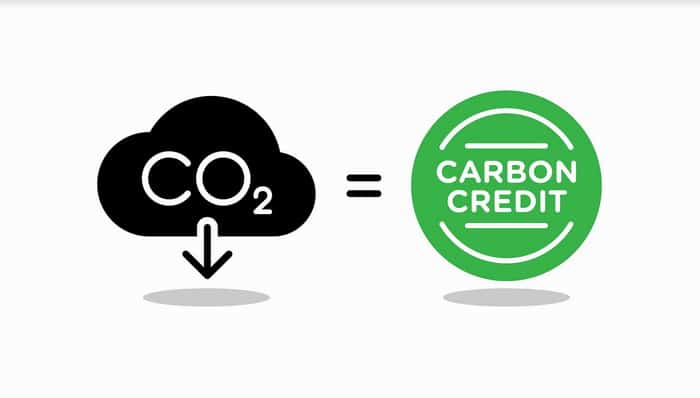How Much Is A Carbon Credit Worth?

Studies show that organizations and businesses are accountable for more than half of global carbon emissions. Even so, it would be counterproductive to ban business operations completely. Doing so would mean crucial sectors of human activity like food production are
cut short. This, therefore, creates a need for organizations to cut down on their emissions while remaining productive.
The Intergovernmental Panel on Climate Change reported that we need to cut global carbon emissions by 50% by 2030 to curb climate change.
The panel has consistently sought strategies and incentives for organizations to encourage them to cut their carbon emission, and one of them is through carbon financing.
Carbon financing involves offsetting carbon emissions by purchasing carbon credits. This article reviews carbon credits and carbon credit prices.
What Is Carbon Credit?
A carbon credit, or carbon offset, permits business owners to emit a specified amount of greenhouse gases. This strategy effectively ensures that businesses compensate for their emissions. Consequently, carbon credit helps to balance greenhouse gas emissions.
If you run out of carbon credit, which means you have emitted more carbon than the allowable amount, you’ll have to purchase new carbon credit. That’s why, you should consider hiring experts to guide you through acquiring your carbon credit.

1 Tonne Carbon Dioxide equals 1 Carbon Credit. image source: Isha Madera.
How Carbon Credit Works?
Carbon credits are measured in tonnes. One carbon credit equals one tonne of carbon dioxide and any other greenhouse gas. Companies that engage in business operations that result in pollution are awarded carbon credits to enable them to carry out business operations sustainably. For every credit, they’re allowed to release a tonne of carbon dioxide and other greenhouse gases. This carbon emission limit reduces periodically.
Carbon offsetting is part of the government’s cap-and-trade program, designed to regulate total emissions. The program aims to reduce the destruction of the environment without causing an economic burden within an industry.
Businesses are required to purchase additional carbon credits once they’ve spent all their credits. They can also benefit from their excess carbon credits by selling to other businesses that have exceeded their limits. How much are these carbon credits? Below is an estimate of how much they’re worth.
Estimating The Price Of A Carbon Credit
The average price of carbon credits in 2019 was $4.33 per tonne of carbon dioxide. In 2020, the price shot up to $5.60, and eight months into 2021, it dropped to $4.73. In the same year, it was declared that the carbon markets were on course to reach $1 billion in transactions, provided all factors remained constant. At the time, both organizations and speculators were buying carbon credits. This investment value became the primary funding source for several green projects across the globe.
In 2022, the price of a carbon credit is estimated to be between less than $1 and $50 per tonne. It barely hits the recommended price range of $40–$80 to meet the temperature goal of the Paris Agreement, which is ‘well below 2°C.’
Numerous factors are essential in determining the price of carbon credits, such as project size, location, and type. Understanding this pricing requires you to comprehend how these prices are determined.
Ways Of Determining Carbon Credit Prices
The price of a carbon credit can be determined through internal or external pricing.
-
Internal Pricing
-
External Pricing
This carbon credit pricing method is helpful to companies that establish internal prices to
inform their investment decisions. The companies utilize internal carbon fee rates or shadow prices to set credit prices.
For internal carbon pricing, the organization imposes a fee for every tonne of carbon emissions involved in all its operations. The total is used to estimate the base prices for credits in the carbon trading market. This option involves the application of a constant rate, making it much more straightforward, albeit less accurate than shadow pricing.
Shadow pricing includes, in the calculation, the cost of the long-term impacts of an organization’s carbon-emitting activities. While this is a complex process, this enables large companies to safeguard substantial investments.
Existing regulations, market forces, international climate change protocols, and the general
regulatory environment influence the external pricing of carbon credits. Crediting mechanisms, carbon tax, and emission trading schemes are three ways to approach this process.
Crediting mechanisms involve establishing the emission rates of different activities and allocating credits to each activity. This is important in ensuring access to funds for offsetting emissions. Then the carbon credits are purchased and sold in the carbon markets. This makes it easy for other companies looking to invest in carbon-offsetting projects so they can acquire credits.
A carbon tax is a price levied by the government on business sectors for their emissions. This compels them to try to come up with ways to reduce their emissions. They can use this information when purchasing carbon credits. This is the most preferred choice, owing to its fixed or stable nature.
The emission trading system involves a cap on the total emissions of a specific sector. The government sets this limit. This system creates a carbon market, where the players can trade carbon credits. This helps to maintain their emission rates within the predetermined limit.
The funds obtained from the credits are channeled toward emission reduction activities. Organizations need to determine the pricing method that suits them best before settling on either.
Factors That Affect The Price Of A Carbon Credit
Numerous factors affect carbon credit prices, including project size, location, and type.
-
Project Size
-
Project Location
-
Project Type
The project size determines the cost of implementation, which affects the price of a carbon credit. Often, smaller-scale offsetting projects have more significant benefits. Nonetheless, they can be expensive to implement and often produce lower
carbon credits. The high costs incurred to facilitate this project and the low supply of carbon credits cause the price of the credits to be high.
Carbon credit prices also vary depending on the location and a region’s access to infrastructure, labor, and resources. Local government regulations may facilitate or hinder the project’s success.
For instance, a project in the Congo Rainforest may yield positive benefits, such as increased local employment opportunities. However, the finances, planning, resources, and permission needed for the success of this project may lead to a spike in carbon credit prices.
Despite the increasing demand for sustainable projects, the benefits of each project vary with the type. For instance, a tree-planting project in a developing country has far more benefits than a wind energy project in a developed nation.
For example, tree planting offsets deforestation, facilitates access to clean water, minimizes erosion and flooding, and provides endangered species with habitats. The tangible nature of these benefits gives investors a sense of the impact they may bring.
Consequently, these benefits and their potential impacts increase carbon credit prices.
Winding Up
A more sustainable approach to achieving net-zero emissions is carbon financing, which involves offsetting emissions by purchasing carbon credits. In recent years, the price of carbon credits has undergone drastic changes. For example, in 2019, the average price was $4.33 per tonne of carbon dioxide, and the following year, it shot up to $5.60. In 2021, it declined to $4.73.
While the price of a carbon credit keeps varying, determining its worth is dependent on the method an organization uses. Besides that, the project type, size, and location also impact the carbon credit price. Overall, carbon credits are an efficient solution for reducing carbon
emissions and safeguarding the environment and its inhabitants.







